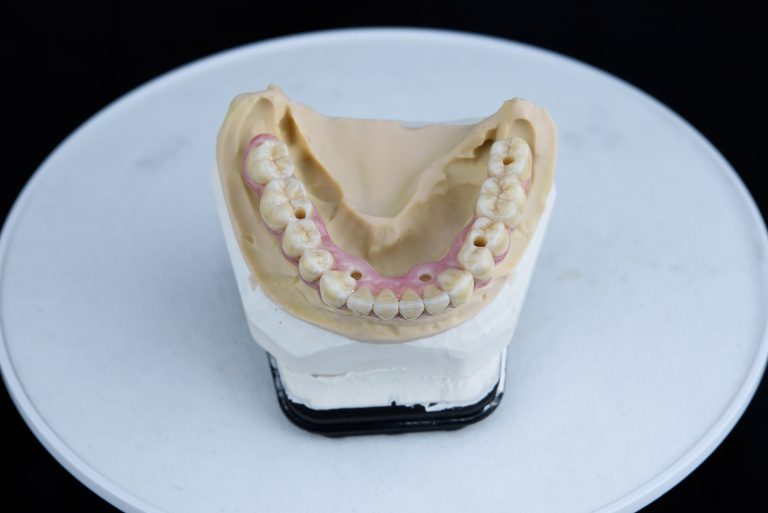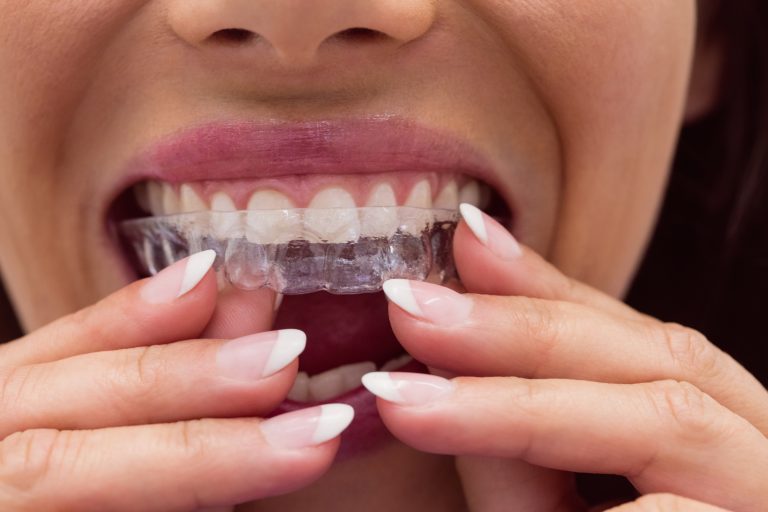


The temporomandibular joint is located on the lower jaw bone, on the right and left. It is distinguished from other joints in the human body by its more complicated structure. The fact that both joint heads are connected to the lower jaw can cause one joint to affect the other in the movements or functional changes of the lower jaw. Therefore, it is important for both joints to be healthy.
The joint heads are located in the cavity of the temporal bone called the “Glenoid Fossa”. There is a particulate disc made of fibrocartilage tissue between the temporal bone and the joint head. In a healthy joint, the particulate disc is positioned between the joint head and the glenoid fossa.
The structures within the temporomandibular joint are protected by joint ligaments made of collagen connective tissue. These ligaments are structured to withstand intermittent forces that may come upon them and restrict joint movements. However, there is a risk that the ligaments will be damaged by continuous and abnormal forces. Moreover, the possibility of recovery of a ligament damaged for any reason is low.
In particular, teeth grinding, clenching and early contacts that occur when teeth are closing against each other are considered to create forces that damage joint structures. When such situations occur, precautions should be taken before damage occurs to joint structures. Because treatment of joint disorders may not ensure that joint tissues return to a completely healthy state. Early diagnosis and treatment can reduce the symptoms and signs of patients and prevent the condition from worsening.
What is Joint Splint?
The temporomandibular joint (TMJ) is a structure that connects the lower jaw on both sides of the head to the skull. The jaw joint enables vital functions in daily life such as chewing, swallowing and speaking.
The jaw joint, which has a complex anatomical structure consisting of muscles, ligaments, discs and bone structures, can be damaged over time due to external factors such as teeth clenching, teeth grinding, poor posture, trauma or stress, and various jaw disorders may occur. Such disorders may manifest themselves with symptoms such as pain, restriction of jaw movements, jaw locking or jaw sounds.
A joint splint is a special appliance used in the mouth and its main purpose is to help treat jaw joint disorders. Thanks to the use of a joint splint in jaw joint disorders, both the effectiveness of the treatment process is increased and the patient’s quality of life is optimized.
A joint splint is a transparent and durable appliance and can be designed to fit both the lower and upper jaws. It is specially produced to relax the jaw muscles, reduce the pressure on the joint disc and support the self-renewal of joint tissues. This appliance is used to alleviate the effects of stress-related bruxism and teeth grinding problems. In addition, it provides advantages such as relieving pain associated with the jaw joint, correcting jaw movements and protecting joint health.
The appliance, which is specially produced according to the oral structure and needs of each patient, can be easily attached and removed from the teeth. It is very comfortable to use. It can be worn throughout the day or only at night.
When a joint splint is first used, patients may experience temporary side effects such as increased saliva flow, slight difficulty speaking, or a foreign body sensation in the mouth. However, over time, adaptation to this device is achieved and complaints are greatly reduced. In addition to regular use, regular dental check-ups are extremely important for the effectiveness of the device and jaw joint health. When used with the correct diagnosis and treatment plan, a joint splint stands out as an effective method for eliminating jaw joint disorders.
What is a Joint Splint Used For?
The most important function of a joint splint is to relax the jaw muscles and provide relief by reducing the pressure on the joint. Conditions such as crooked teeth, incompatibilities and early tooth loss can negatively affect jaw closure. Jaw joint problems that occur can sometimes turn into a habit and lead to more serious problems.
A joint splint eliminates the tight contact of the teeth with each other, allowing the jaw to move freely and naturally. The tight contact of the teeth can create tension in the jaw muscles and cause pain. Thanks to the joint splint, the lower jaw and the attached muscles perform their functions properly. In this way, it ensures that the jaw joint is placed correctly. As discomfort related to the muscles and joints decreases, pain caused by the joint disappears.
In addition, a joint splint can also help control habits such as clenching and grinding teeth. In the early stages of treatment, it can provide temporary relief by masking the effects of discomfort in the jaw and dental problems. The temporary relief it provides also makes it easier to identify more serious problems in the jaw and teeth. Regular use of the splint ensures that the long-term treatment plan is created correctly.
Why is a Joint Splint Performed?
A joint splint is generally preferred in the treatment of jaw joint disorders caused by habits such as teeth grinding (bruxism) and clenching. The temporomandibular joint and even the surrounding muscles, bones and ligaments can be damaged due to teeth grinding and clenching habits. The person’s quality of life can be negatively affected by this condition, which affects the jaw’s movement from side to side or back and forth.
A joint splint is applied to treat problems in the jaw joint and to relax the jaw muscles. In addition, reducing stress, relieving pain felt during chewing and preventing wear on the teeth are among the purposes of using a joint splint.
A joint splint is specially designed and produced for the person to support a correct jaw closure. Jaw locking, limited mouth opening and pain felt during chewing are among the most common symptoms of temporomandibular joint disorders.
The use of a joint splint day or night is important for the success of the treatment. Regular and correct use in accordance with the dentist’s recommendations enables effective results to be obtained during the treatment process.
When to Use a Joint Splint?
Symptoms of discomfort in the jaw joint often appear gradually and may be difficult to notice at first. Early diagnosis is possible when symptoms such as restriction in jaw movements, noise when opening the mouth, tooth wear and pain in the head and neck area are taken into account. Such problems can cause the jaw to close in the wrong position and can lead to more serious problems if neglected for a long time.
The decision on when to use a joint splint is made according to the specific needs of each patient. After symptoms such as teeth clenching, teeth grinding or problems in the jaw muscles are diagnosed, the dentist can start splint treatment. Conditions such as disc displacement in the temporomandibular joint or misalignment in the lower jaw are also important signs for applying the joint splint treatment method. The patient’s progress in the treatment process is monitored with regular check-up visits and changes can be made to the treatment plan if necessary.
In What Cases is a Joint Splint Used?
A joint splint is a treatment method used in many disorders affecting the jaw joint and tooth structure. Especially stress-related teeth clenching and grinding (bruxism) puts a great burden on the jaw joint. It can cause complaints such as tooth abrasion and sensitivity, difficulty chewing, earache and headache. Grinding or clicking sounds when opening or closing the jaw, jaw contractions, pain and strain during stretching also necessitate the use of a joint splint.
Joint splint is preferred in the treatment of disorders caused by posture disorders, alignment problems in the teeth and jaw closure disorders as well as stress. In addition, it is an important tool in the treatment process of serious temporomandibular joint problems such as jaw locking or dislocation.
Joint Splint Prices
The price of a joint splint varies depending on various factors such as the scope of the treatment, the type of splint and the quality of the material used. The apparatus, which is specially produced for each patient, is designed in line with the measurements specific to the person. This is also among the factors affecting the cost. In addition, factors such as the expertise of the dentist performing the treatment, the region where the clinic is located and the pricing policy are also decisive.
Since the needs and treatment plans of each patient vary, a standard joint splint price cannot be mentioned. In order to learn about joint splint prices, it would be best to see a specialist dentist and get information after a detailed examination. It should also be remembered that health problems related to the jaw joint can progress if left untreated.
Patient Comments
In our clinic, we are ready to meet all your dental health needs with a warm welcome, transparent communication and superior service quality.
I went to see her about my veneers and cysts had formed under them. I had an implant and now I am very happy. I went to 3-4 dentists before Ms. Esra but they always caused problems and broke my teeth from the roots while putting the veneer on. They finally recommended Ms. Esra and I went and was very happy. She is a very light-handed and knowledgeable doctor who saved all of my teeth with root canal treatment. I recommended her to my relatives and family. Some of my family members also went there.

zü...ç
TR

em...ş
TR
Frequently Asked Questions: “Joint Splint“
An oral splint helps to improve jaw joint or dental disorders by keeping the teeth and jaw in a certain position. It also protects teeth and reduces wear in conditions such as bruxism.
An oral splint is a specially designed device that is worn inside the mouth. Placed on the teeth, this device is used for purposes such as correcting jaw position, controlling habits such as teeth grinding (bruxism), or treating temporomandibular joint (jaw joint) disorders.
When using an oral splint, it should be cleaned and maintained regularly. In addition, your dentist’s instructions should be followed regarding the use of an oral splint. If discomfort or pain is felt during the use of an oral splint, your dentist should be consulted immediately.
Joint splints are often used to treat conditions such as jaw joint disorders, bruxism, temporomandibular joint dysfunction (TMJ). They can also be used to treat sleep apnea or when teeth need to be protected at night.
